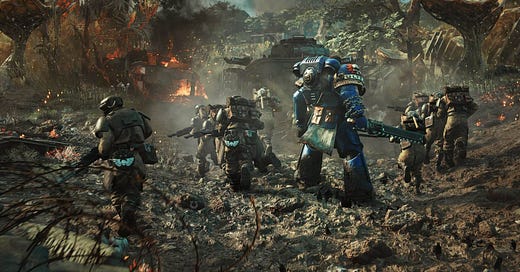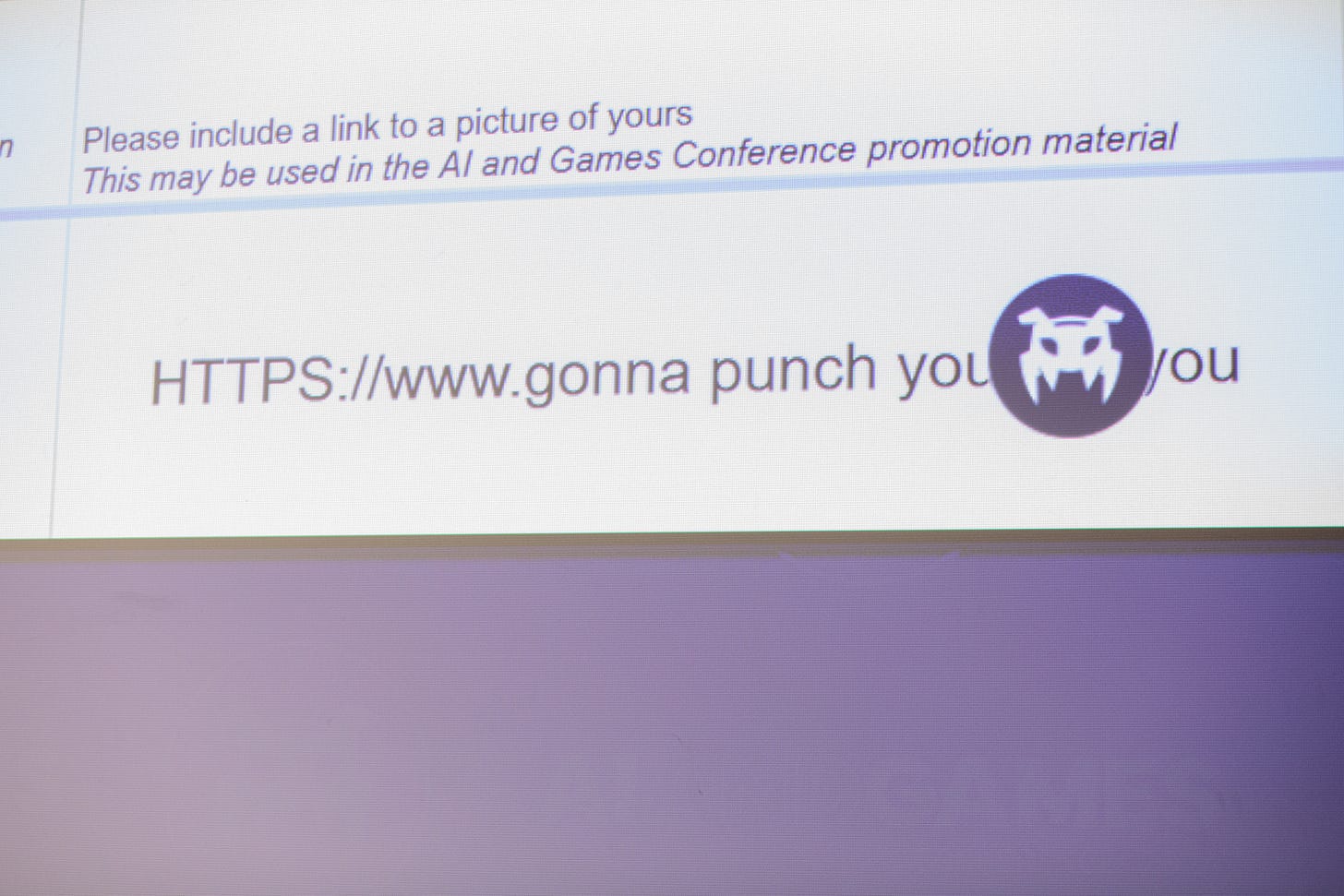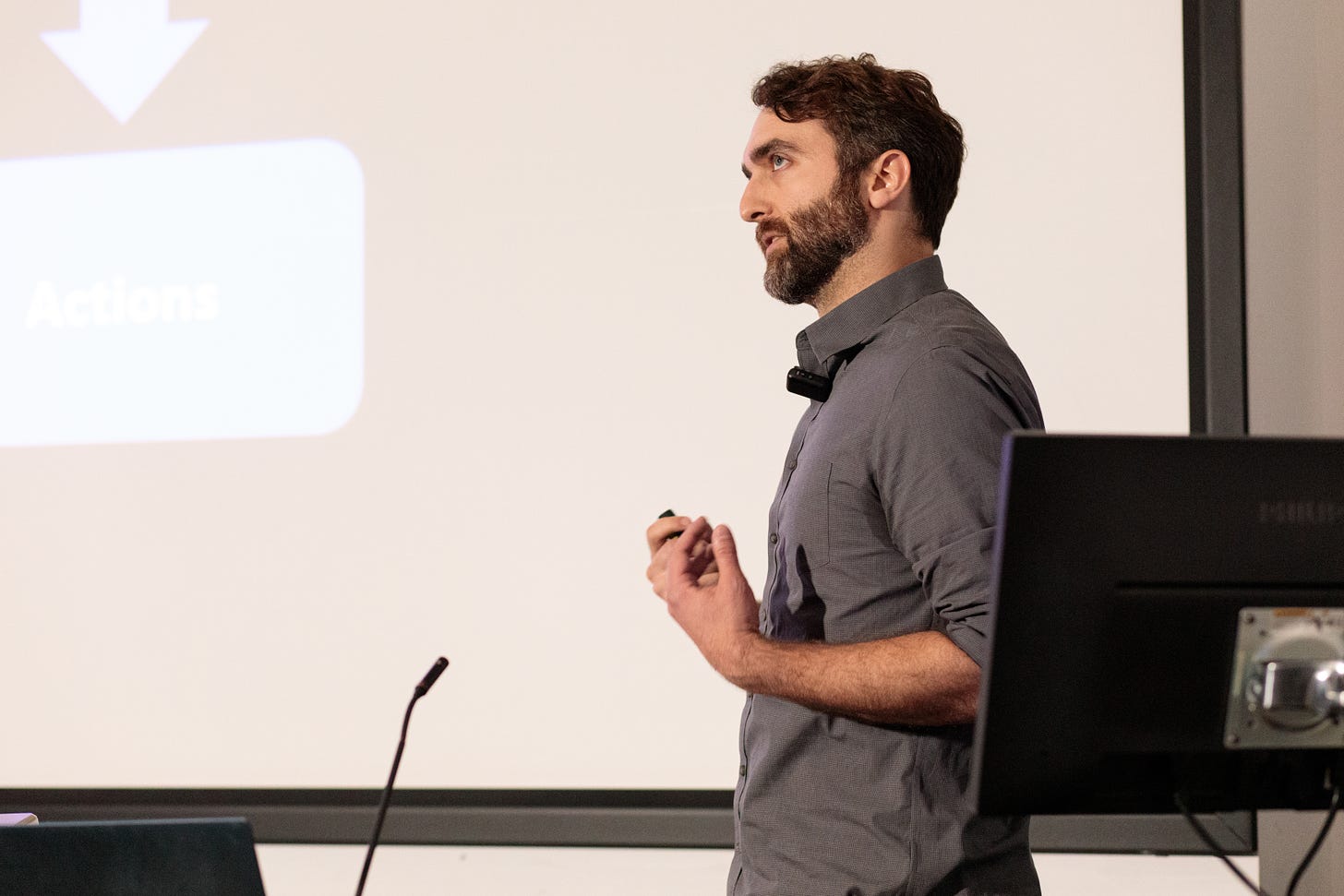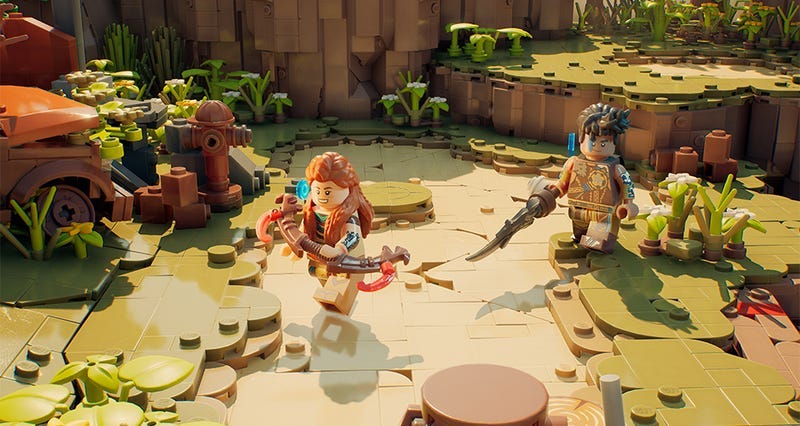Why Space Marine 2's AI punishes you for being a wuss, 14/11/2024
And four other things I learned at the AI and Games Conference
Space Marine 2’s game AI hates cowards, according to Saber Interactive’s Lead Designer
Trump tariffs could raise console prices by 40% in the US
Lego: Horizon Adventures bricks its way to the top of the week’s releases
| Find me on Linkedin | Follow me on Bluesky | Pre-order my book | Email me |
Good morning VGIM-ers,
Today is a very fun day.
Later this evening, dozens of readers will descend on a pub in Central London to belatedly celebrate the publication’s first birthday with the support of the team at Big Games Machine.
But before we get to an evening of festivities, we have a newsletter to read.
And as per usual, I have a few speedy points of order for you all to pay attention to before tucking into the big read.
First, entries for Video Games Industry Memo’s Game of the Year remain open. We have had loads of great submissions so far BUT lots of big games (Astro Bot! Space Marine 2! The latest Zelda!) haven’t received any love yet.
If you enjoyed any of those games - or have another title you want to tip - email me a 200-300 word review of it before Friday 6th December to be in with a shout of being featured in the final newsletter of the year.
Second, it’d be remiss of me if I didn’t mention again that the cost of sponsoring VGIM is going up in 2025 to reflect the fact that the readership has more than doubled in size.
If you want to be in the newsletter read by industry bigwigs, leading journalists, Big Tech powerhouses and policy makers in all of the West’s major regulatory centres (and do it at 2024 prices), pop me a message while you still can.
And finally, Ask George lands in inboxes tomorrow lunchtime for my lovely VGIM Insiders.
If you’d like to read the post and get access to other perks, including extra newsletters, first dibs on event tickets and 10% off sponsorships, you can become an Insider at a whopping 33% this week only in celebration of VGIM’s birthday.
Enough of all that though. Let’s discover why one of the biggest games of 2024 hates scaredy cats.
The big read - Why Space Marine 2’s AI punishes you for being a wuss
After four frantic months of organising, the AI and Games Conference took place in London last week.
The event, which was pulled together by Tommy Thompson of AI and Games and a crack advisory board featuring experts from Goldsmiths University, Splash Damage, Creative Assembly, Ubisoft Montreal and TVG Events (and me), brought together over 250 games AI professionals to learn from leaders in the field, talk shop and enjoy a delightful sandwich buffet.
For those of you interested in how the conference came together, Tommy will be serving up a post mortem on the AI and Games Substack - which I fully recommend you read when it lands in the coming weeks.
But after spending months working in the background on the event making spreadsheets, shoving together sales decks and hoping that the numbers all added up to a healthy profit (which, thankfully, they did), I thought it’d make sense for me to watch some of the talks on the day to actually try to learn something from the event I was helping to put on.
And amongst the five things I learned that day, the one that was most interesting for me was finding out that one of the best games of 2024 - Space Marine 2 - really doesn’t want you to play cautiously.
Lesson 1) Game AI needs an event like this to tell its full story
Before we get to that glorious nugget of information though, it’s worth taking a moment to restate why the event happened in the first place.
The opening talk from Tommy gave everyone a rounded picture of how the AI and Games Conference transformed from a semi-formed thought in the halls of Game Developer Conference (GDC) earlier this year into a one day conference barely eight months later.
From a purely practical perspective, Tommy said there was simply a need for a games AI event for professionals based in Europe.
Despite forming a key part of the games industry, there hasn’t been a dedicated conference for the discipline on the continent for just over seven years.
Creating an event in London in the second half of the year gives games AI professionals in the region another chance to come together, share expertise and trade war stories - something that supports a year round dialogue within the discipline in the process.
Arguably more importantly though, the conference was framed from the outset as an opportunity to rebalance the debate around AI and games to reflect the reality of the profession.
As Tommy showed during the opening talk, running a conference about games and AI prompted submissions from some interesting characters who have interpreted “games AI'“ to mean “generative AI”.
And while generative AI is certainly a growing part of the discipline - and something that was covered at the conference, as I demonstrate later - Tommy explained that the use of AI in games is much broader and much more deeply rooted within the medium than the current public debate suggests it is.
So by drawing together speakers from across the industry who are using a variety of AI technologies in a number of different contexts - from using AI to foster effective flying and swimming behaviours of an in-game mount or to calculating analytic geometry to make sure objects in games are positioned properly - the conference sought to show that breadth in action: readjusting the debate around the medium in the process.
Lovely, eh?
Lesson 2) Space Marine 2’s AI punishes you for playing like a coward to reinforce its central conceit
What’s the best way to encourage a player to behave aggressively when they’re put in the shoes of an over-powered space super soldier? Why, you punish them for being a wuss of course.
In his post mortem of Space Marine 2, Vladislav Iantsevich, Lead Game Designer at Saber Interactive, outlined how the AI design for the game sought to hinder those who beat a retreat - while rewarding those who waded into combat.
As Vladislav explained, Saber’s main aim with the game was to encourage players to inhabit the peculiar power fantasy that sits at the heart of being a Space Marine in the Warhammer 40,000 universe.
On the one hand, you are a power armoured super soldier who towers over enemies on the battlefield and can meaningfully rip apart most of your foes with the merest wielding of a chainsword (or the firing of a bolt pistol).
But on the other hand, the Space Marines are almost always outnumbered by every single foe they face and often butt up against similarly overpowered enemies - such as Chaos Space Marines - who make every battle a fight to survive.
So to encourage players to live the power fantasy of being a Space Marine while facing the reality of a grim uncaring universe (no jokes about the election result last week, please), Saber designed its AI system to encourage players to dive into - and tough out - the kind of furious battles that your average super soldier would find themselves in.
And while they achieved this in a number of ways - including by giving players plenty of pulverisable enemies to punish to balance out the times when a Terminator comes storming into your face to mess up your day - one of the major ways they achieved this was by rewarding people who played courageously.
Players who do bring their Space Marine into close combat with opponents, flipping between melee weapons and short range guns as they see fit, are given benefits like occasional breathers mid-combat to reposition and a lower chance of being hit by ranged weapons when engaging in close combat.
But players who retreat to a distance are consistently punished for doing so, including through being opened up to stealthy off screen attacks from enemies which Saber deliberately implemented to punish passive play.
It is a devilish, and in a few ways kinda unfair, decision. But given that Space Marine 2 is all about forcing you into frantic and tough combat as often as possible, it's a subtle design choice that goes a long way to encouraging you to play in a way befitting the Emperor’s finest.
Lesson 3) Fortnite’s bots train at a data gym
Making bots behave in a way that feels as plausibly human as possible is important for making a variety of games feel immersive, especially within a context like a popular multiplayer game.
The problem is how to achieve it. While bots can be programmed to behave in certain ways, humans are simply intuitive, creative and purposeful in ways that a pre-programmed bot can’t be - making it far too obvious when you’re playing against one that simply can’t dynamically adapt to changing play styles.
So instead of programming bots to behave in a specific way and leaving them to fend for themselves, Brendan Mulcahy, Lead Research Engineer at Epic Games, showed how an Unreal Engine plugin called Learning Agents has been putting Fortnite’s bots in a “data gym” to allow them to get smarter by learning from their environment and the people they play against.
As Brendan explained, Fortnite’s bots need to behave compellingly like real players for two reasons: to help players who aren’t quite ready to engage in player-to-player battle to get to grips with the game and to top up higher level lobbies with challenging extra enemies to ensure the game’s best players aren’t waiting around too long for a match.
To that end, Brendan outlined how the company put their bots into mini “data gyms” outside of the game environment and used machine learning - in the form of reinforcement learning (RL) and imitation learning (IL) - to teach them how to play the game more effectively.
By using RL to make sure that bots reward themselves for taking useful actions (e.g. helping it realise that opening a chest with a shiny new weapon in it is a good thing) and using IL to encourage bots to mimic human behaviour that leads to better outcomes (e.g. crouching when an opponent does to make sure you’re shooting on the same level), Brendan showed that it was possible to turn a bot from little more than a moving target into a meaningful challenge with barely half a day’s worth of work.
And while such an approach has its limitation for now - for example, dynamically adjusting to new player strategies that are emerging live within a game that hasn’t been tested for in the “data gym” - Brendan showed that RL and IL is both effective and increasingly accessible for developers: opening up their potential benefits to more developers in the process.
Lesson 4) A “human hand” is an important way to reduce risk around generative AI use
While the AI and Games Conference sought to show the breadth of AI technologies used within games, it did provide some thoughtful insight into the state of play around generative AI within games.
And amongst the talks I saw, Anna Poulter-Jones, an Associate at Sheridans - who, for full disclosure, is actually my lawyer, thank you very much - gave valuable insight into both the current state of the legal debate around generative AI and tips on how to minimise risk when using it.
The major problem with using a generative AI tool is that the material which feeds into a large language model’s dataset may be subjected to a series of usage rights - including copyright, trademarks, design rights and image rights.
And while Anna did explain that models which train themselves on data that could be subjected to such rights can often allow other parties to use their services for non-commercial purposes, a company that uses such a tool with a commercial goal in mind can quickly land themselves in legal hot water.
However, Anna did have some guidance on how businesses can use generative services responsibly to support creativity within game development.
One way to do this is by doing what every lawyer loves and checking the terms and conditions of a service, especially in regards to licensing rights that a generative AI service may (or may not hold).
Another is to ensure that you don’t prompt tools using terms or assets that are likely to be subject to rights issues. Asking an image generation service to serve up “Garfield in a BMW” is more problematic than asking for a “cat in a car”, for example.
But her main piece of advice was to ensure that any generative content is edited by a “human hand” to ensure that your business’s ideas come to the fore.
As Anna explained, serving a piece of generated content straight into a game or as an asset like a marketing screenshot means your work solely leans on the dataset - putting you at the mercy of the service you’re using.
But by adding a concerted human edit on top of the base asset - for example, by using it as a jumping off point for ideation but handing a designer the chance to create something unique in the company’s house style - Anna said that there was more room to show generative AI as one part of your creative process: reducing your risk in the process.
And although Anna was keen to stress at the start of her talk that the session did not constitute legal advice (soz, everybody), it was nevertheless reassuring that her non-legally binding tips around the use of generative AI shows that there is real importance in maintaining that personal touch in the creative process.
Lesson 5) Less “making games is magic”, more behind the scenes access
Finally, the AI and Games Conference reinforced to me the importance of the games industry taking a proactive approach to show clearly how video games are made.
For so many people working in games, there’s a desire towards maintaining the “magic” of creating video games which leans towards secrecy in regards to the creative process.
There are understandable reasons for this. Games creators don’t want to give away all the secrets of their development process in case a rival pinches it. And as one attendee put it to me, many video games are essentially ‘performative’ - drawing players into their worlds through clever design and occasional sleights of hand that benefit from just a bit of misdirection.
But the thing about games is that the medium has had long term reputational issues. The dominant cultural mood towards games is one that can probably be best described as negative, with an expectation that the industry is engaging in behaviours that could be exploitative or, lord forbid, “addictive.”
The veil of secrecy around games therefore becomes a problem. While people might think it is useful for maintaining the “magic” of the medium, critics are in fact empowered to argue that the spell that the industry is casting must be arcane - something that’s problematic to the sector at large.
Therefore, the openness of the AI and Games Conference was a useful reminder of the value of openness in helping people understand what games actually are.
Even beyond the sessions outlined, I actually learned a remarkably large amount about the nuts and bolts of game development (e.g. how Horizon: Forbidden Dawn’s Sting Spawn decide what behaviour to engage in via something called a Hierarchical Task Network) that could prove interesting to audiences well beyond the lecture halls of Goldsmiths University.
Film, TV and theatre learned long ago that behind the scenes footage was both engaging for consumer audiences and a powerful tool to showcase the depth of thinking (and expertise) that goes into the way that the industry functions.
And while the games industry has plenty of creators and influencers who do tell that story - such as the now decade old Game Maker’s Toolkit - it would be truly great if the industry itself could gun for transparency as the norm to give it a much better chance of boshing away its reputational worries.
News in brief
Trumped up: The Consumer Technology Association has claimed that potential incoming tariffs from a Trump administration could increase the costs of game consoles in the US by 40%. While the association successfully lobbied against tariffs during Donald’s last session in The White House, it is out quickly banging the drum just in case he actually does do what he says he will do for once.
Games no-earn-alism: Why is games journalism struggling? It may just be due to the piss poor pay rates being doled out to the people doing it. Luke Plunkett of the Aftermath has a run down on how much - or in this case little - cash freelance writing gigs score your average games journalist. You know what they say about paying people peanuts…
Raided: The Modern Times Group, who you may know for buying up London based Hutch Games, has snapped up Plarium - the makers of widely memed Raid: Shadow Legends - from Aristocrat. The deal, which is currently valued at $620m but could climb to $820m, comes after months of speculation that the company was up for sale.
Nintendon’t cross this legal team, part 1,678: Nintendo has filed a lawsuit against a streamer called Jesse Keighin after he streamed “at least 10 of Nintendo’s most leaked games” before they hit the market (including last week’s Mario & Luigi: Brothership). My favourite part of the story is Nintendo’s description of Keighin as a “recidivist pirate” - a phrase worthy of Robert Louis Stevenson.
Bricking it: Alexey Pajitnov, the creator of Tetris, was interviewed by The New York Times to mark the release of Tetris Forever. Despite being put out to press to promote the new puzzle collection (see more in the games of the week), Pajitnov instead told interviewer Sam Machkovech that “I don’t like to talk about success” before going on to talk about his many non-Tetris related failures throughout his career. Got to respect anyone capable of going so fundamentally off message, to be honest with you.
Moving on
Nick Allan has joined Mishcon De Reya as a Partner to head up its games team…Robbie Cooke has become the Head of Brand - Metro at Plaion…Chantal Zuurmond has popped up as Head of Production over at Forthstar…Alison Lacy is the new COO of Radical Forge…And speaking of someone else taking on that kind of role, Alex Blum has just been promoted to COO over at Unity too…
Jobs ahoy
Scopely is hunting for a Regional Director Marketing EMEA for its Monopoly Go empire…Tencent is looking for a Production Director…Sony Interactive Entertainment is hiring a new Subscriptions Experience Associate Manager to join its team…Meta is recruiting a Director Shared Services, Oculus Studios in Burlingame…And for a change, why not tip San Francisco State University’s opening for an Assistant Professor, Video Game Studies, Humanities and Comparative World Literature to join its faculty…
Events and conferences
G-Star 2024, Busan - 13th-17th November
The Playing for the Planet Awards, Helsinki - 18th November
Slush, Helsinki - 20th-21st November
Africa Games Week, Cape Town - 2nd-5th December
The Game Awards, Los Angeles - 12th December
Games of the week
Lego: Horizon Adventures - Aloy gets blocky in this new third person action game landing on PS5, Switch and PC.
The Rise of the Golden Idol - Sequel to hit detective game The Case of the Golden Idol lands across platforms.
Tetris Forever - Explore 40 years of Tetris history in this compelling compilation of games and documentary footage.
Before you go…
Get a head start on your fitness related New Year’s resolutions by buying yourself the new fighting game powered wellness device from Japanese manufacturer Tanita.
It has teamed up with SNK to create a new set of scales which can tell you your weight, measure your body fat percentage and, most importantly of all, let you play legendary beat-‘em-up The King of Fighters ‘98: Dream Match Never Ends.
What a world we live in!










As a person who just bought Space Marine 2, this is definitely true. If you are not right in the middle of the action, you are in big trouble 😅